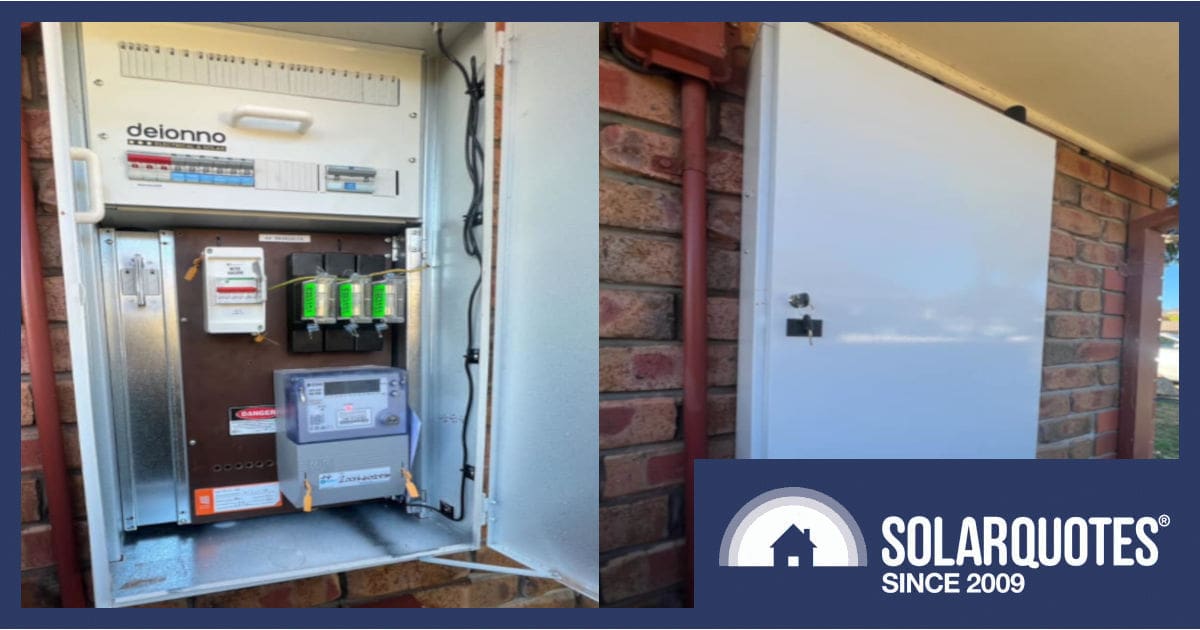
An excellent 50-pole switchboard upgrade. An absolute credit to Deionno Electrical & Solar
Despite modern electrical standards calling for spare space in switchboards, even brand-new places can struggle with switchboard space when adding solar, battery or EV charging equipment.
We’ve written previously about switchboard upgrades, but it’s worth reiterating here that modern living requires much more room, especially if you’ve got a 3-phase supply.
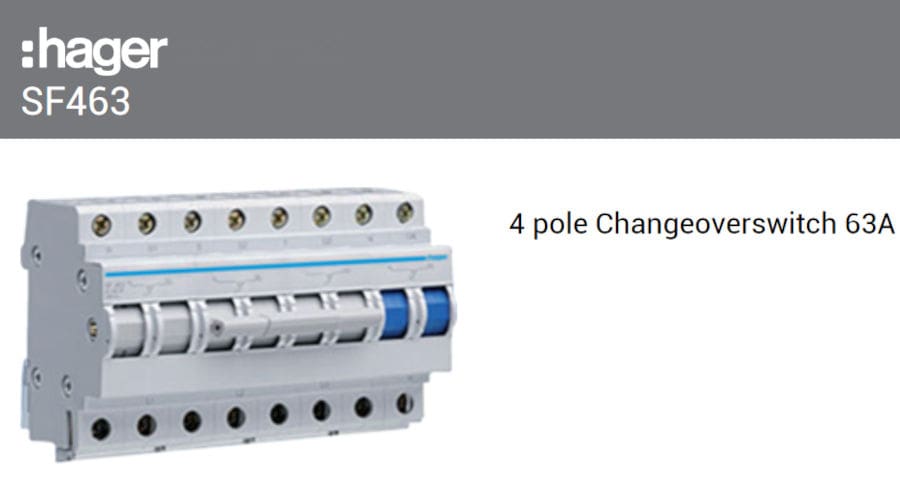
This is a changeover switch, used to swap your house from mains supply to a generator. Electrically speaking it’s technically a 4 pole switch, but it requires space for 8 poles in your switchboard.
Understanding Jargon; DIN Rails And Poles
If your house has ceramic fuses and switches mounted on a board, then it needs an upgrade.
Modern circuit breakers, switches, relays & meters all fit onto a standard mounting called a DIN rail which is built into a surface mount enclosure or the switchboard itself.
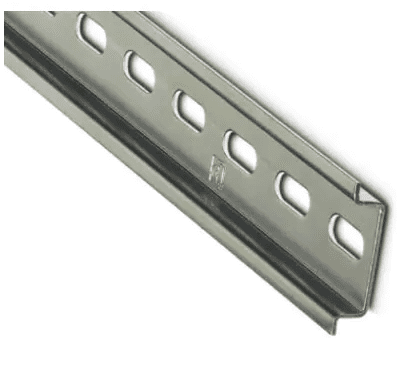
DIN rail is used to mount most switchboard components
Each 17mm wide unit is referred to as a “pole” so for example a 2-pole device which requires a live and neutral connection is 34mm wide:
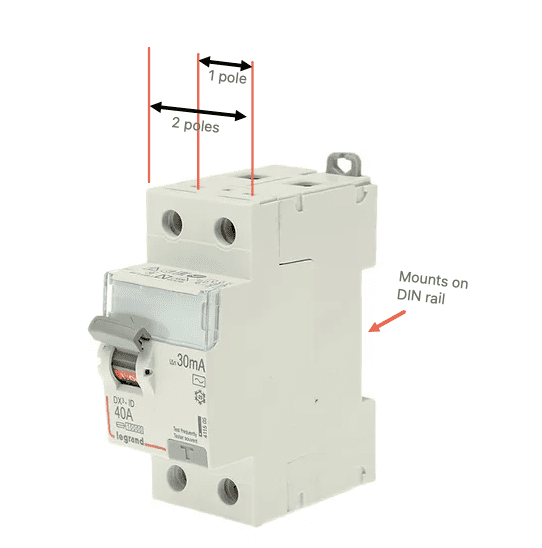
A 2-pole device
A 12 pole switchboard can fit:
- twelve single phase circuits
- or four 3 phase circuits.
If you want add a solar panels across 3-phases , a 3 phase EV charger and a control circuit then you may need space for 12 additional poles in your switchboard.
Consumption meters may be hidden behind the panel, or may take up 5½ poles by themselves.
Bigger Boards Are A Blessing
If you have to overhaul your main switchboard, it really doesn’t take much extra effort to future-proof the place with more room.
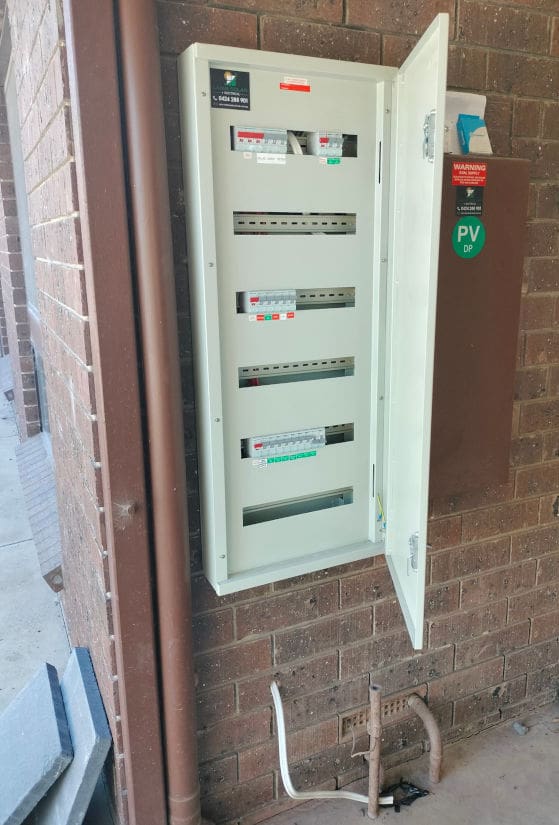
Lewis May from LAMM Solar and Electrical took things to another level on his own place. 96 poles of space to organise home automation.
Full Boards Require Full Blown Overhaul
It can be easier to add a large external sub-board, perhaps in the garage or other end of the house. One of my best outcomes was getting a customer to think about longer term aims, then planning to suit. A 36 pole sub board was placed right beside the hot water service, air conditioner and new solar inverter while only 7 poles were needed in the main meter position.
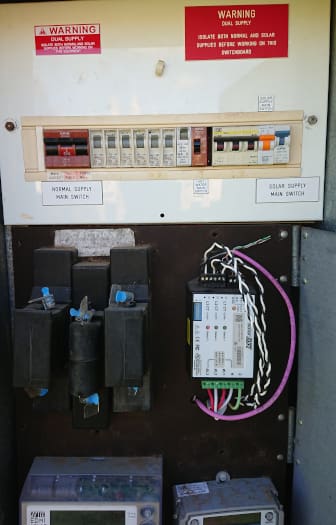
Starting with a single phase switchboard, 3 phase has already been added and the consumption meter (using pink data cable) is fitted illegally with exposed live parts on the front of the meter panel.
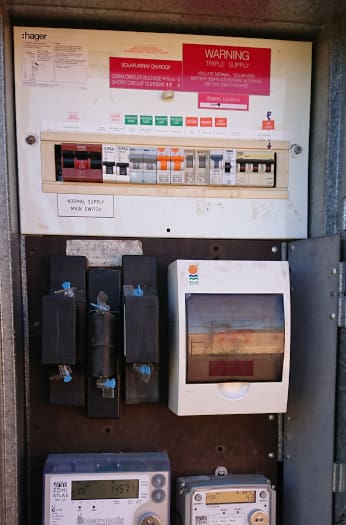
Progress made, with enclosure for extra metering and half a pole to spare at each end of the main DIN rail.
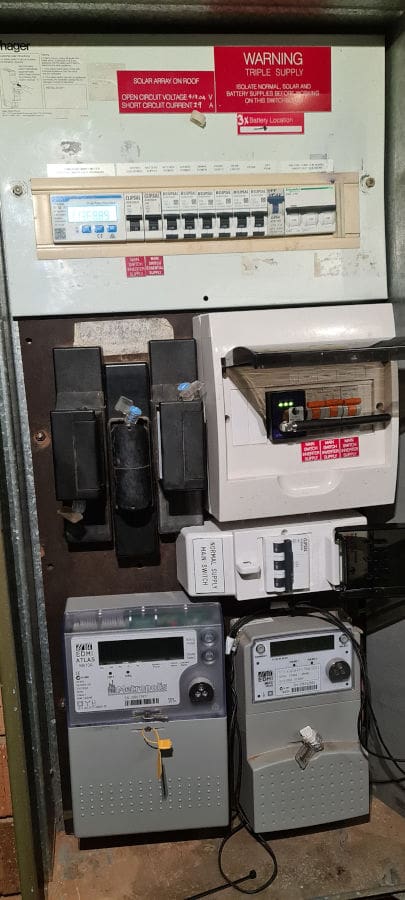
Packed like sardines. Meter isolator as main switch installed sideways. 2 utility meters, 3 consumer consumption meters and a sub board supply instead of an air conditioner.
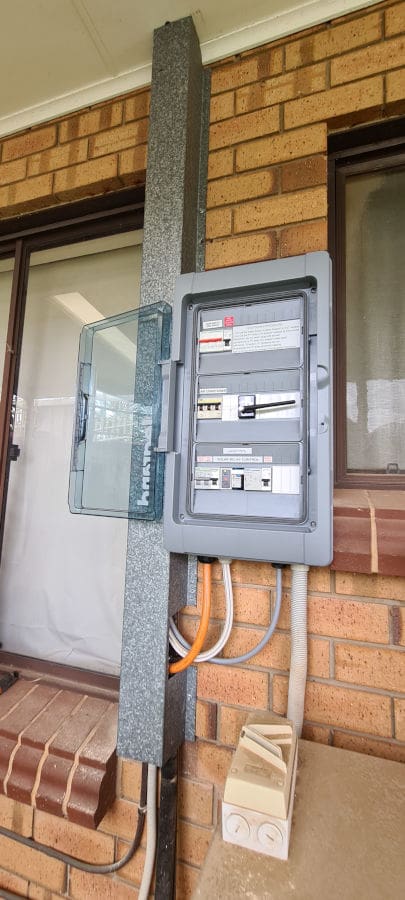
36 pole switchboard with abundant space for air conditioning, solar, consumption meter & hot water control circuit. The EV charger will be added here.
A Benign Looking Example
This two-phase domestic switchboard had been updated within the last ten years, but it was packed full.
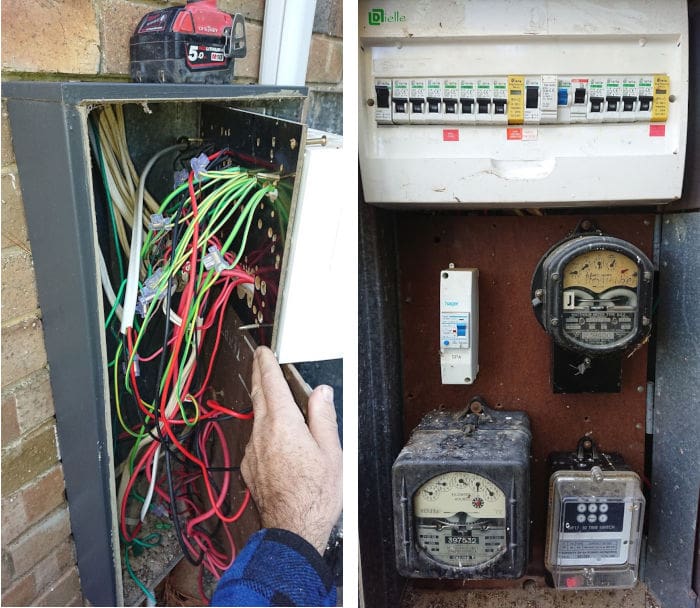
Despite being updated this switchboard still needs attention. The time clock will be removed so two meters can go side by side, freeing up space for a meter isolator and more consumer circuits like the spa… and solar.
You never really know what you’ll find until the covers are off. In this instance, the electrician who quoted the solar should have tweaked something wasn’t quite right simply because there were two main switches. He was qualified to remove the escutcheon and pinpoint the problems but a non-electrician isn’t legally able to take this picture below.
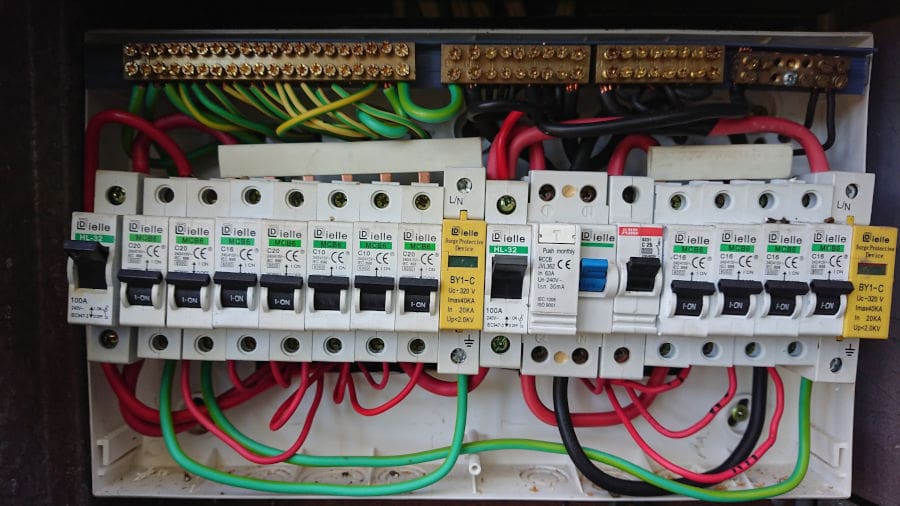
This board was neat enough, but two main switches should be ganged together and should have a red toggle, and these days, there needs to be twelve safety switches, not just one.
Communication Is Key
Many solar businesses rely on quotes via satellite, which isn’t a bad thing but you can have a virtual visit by sending photos of your switchboard to whoever produces the quote. Even if you have a new and supposedly compliant house there can be surprises, but photos offer documentation which can prevent surprise charges on the day.
The best installers will have a qualified trade visit your place, measure up and document what’s needed. Choosing the $500 cheaper quote can really sting if install day discovers an additional $1500 expense.
If you consider the grief or conflict that potentially means the job is incomplete, it’s worth organising an inspection at the outset.

 RSS - Posts
RSS - Posts



100% this!
in NSW need extra 1/2 pole space between main switch and other CBs for sealing if needed, plus can ‘bury’ private meter behind SB only if there is depth available / space not consumed by birds nest cables etc etc – great commentary / thoughts, thanks Anthony
I knew our switchboard wasn’t going to cut the mustard when we had our EV charger installed and I asked for a sub-board (located 3m away).
The electrician pushed back so much (why?!?!?) I simply gave up. When he was struggling to put the cover back on the mass of wires in the overcrowded switchboard I simply said “Would have been much easier with a sub-board”.
He didn’t say a word in response.
I now have another board with 36 elements which is great.
Except no-one will put in an 80 amp switch leading in to it (63A mains feed + 20A from solar). The cabling b/w the two is sufficient so who knows why not…
Dale,
It’s the same here, off-grid with 16 KVA of battery inverters + 12 kW of AC coupled. The 63A main switch on the grid forming inverters limits them to providing 14.5 kW. The potential 50A from the AC coupled PV does mean there could be 113A on the switchboard comb, if I could find 26 kW of loads, and there was enough sun. The EVSE, HWS, microwave, and kettle reach just half that. The welder can then wait, I figure.
There’s a main and two sub-boards here – very manageable. Stuff is nicely compartmentalised – no need to dodge unrelated wiring to focus on the item of interest.
Anthony, i
Interesting but why not put an approximate cost alongside your examples? Particularly so for the example where the system was improved in stages. Just telling us all how clever electricians are without providing as much information as possible seems a little pointless.
Hi Ian,
As an electrician I was involved with the tools on the ground, pricing these jobs was wrapped up in the quote along with solar and battery, by a sales process I wasn’t involved in as much. I just got sworn at for taking too long to successfully achieve the impossible.
These days the consensus amongst trades I know is that a switchboard upgrade generally starts at $1200
Love the sloping bridge terminating of the SPD – sparky must have been late for tradie happy hour.
This was discovered during my house build. I now have 2 switchboards.
As I haven’t moved in yet, I’ll need to figure out what is where, particularly with 2 batteries, 3 phase, and solar.
this is ugly and should not be held out as good practice for a new install,
“36 pole switchboard with abundant space for air conditioning, solar, consumption meter & hot water control circuit. The EV charger will be added here.”
there is no way I would accept that mess on the brick at my place.
Hi Ron,
Did you see the packed like a sardine switchboard above? How would you put even more equipment in that box? The customer didn’t have an appetite for cutting the wall open and fitting a whole new board, nor the budget to waste money on DNSP fees for disconnect/reconnect of the service.
The solution here re-uses legacy wiring and the existing metal duct for air conditioning & hot water plumbing. The 3 phase air con isolator is literally in the foreground, while the hot water service is an arms reach away and solar inverter is 4 metres in the other direction. All protected under the back verandah.
Retrofitting all this gear means it has to go somewhere, aesthetics are hardly an argument when you struggle to find a place it’ll fit.
My house has the external switchboard, my Tesla Powerwall switchboard next to it and internally (so I don’t have to go out in the weather) an internal sub board with the house circuits. When I got solar they gave it a sub board of its own as well.
Want to knock out the whole house the main board has you covered. Solar you hit the board with a big Ephase logo. Batteries are the Tesla board and any individual circuit check the internal sub board.
A lot of the sub boards also have a take everything offline at once switch in them too.
I guess by including their own sub board for the solar/batteries an installer saves themselves from worrying about space in the main board in most cases.
P.S Also love the internal sub board. It’s saved me many trips out into a storm to reset a circuit.
Great article Anthony thanks. I recently had heat pump hot water installed (replacing gas) and the electrician somehow squeezed it in. Mine is all single phase. I have solar but no battery. And I have 4 reverse cycle AC units. I said to electrician I am surprised I don’t have more circuits. He said it complies at present. Problem is each addition is “squeezed” in and I assume complies. But I am concerned about running all devices at once. I plan to get an electrician to review the whole set up and probably upgrade the board.
love the info and the conversation, thanks Anthony & team – tis a complex little world we live in with so many options… (& better to allow 18mm per pole)
Thanks Mark,
We try to help where we can.
Cheers